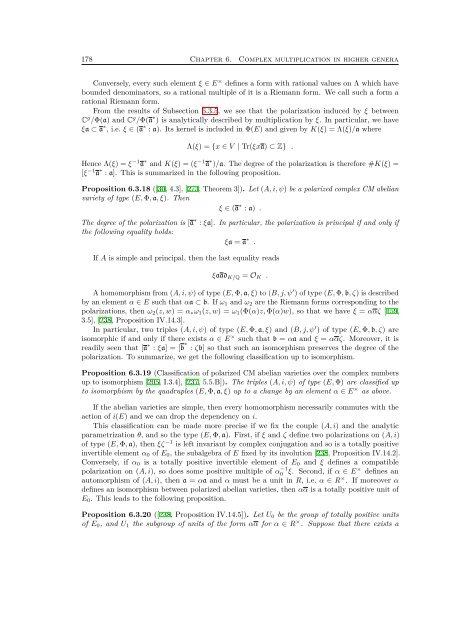here - Sites personnels de TELECOM ParisTech - Télécom ParisTech
here - Sites personnels de TELECOM ParisTech - Télécom ParisTech
here - Sites personnels de TELECOM ParisTech - Télécom ParisTech
Create successful ePaper yourself
Turn your PDF publications into a flip-book with our unique Google optimized e-Paper software.
178 Chapter 6. Complex multiplication in higher generaConversely, every such element ξ ∈ E × <strong>de</strong>fines a form with rational values on Λ which haveboun<strong>de</strong>d <strong>de</strong>nominators, so a rational multiple of it is a Riemann form. We call such a form arational Riemann form.From the results of Subsection 6.3.5, we see that the polarization induced by ξ betweenC g /Φ(a) and C g /Φ(a ∗ ) is analytically <strong>de</strong>scribed by multiplication by ξ. In particular, we haveξa ⊂ a ∗ , i.e. ξ ∈ (a ∗ : a). Its kernel is inclu<strong>de</strong>d in Φ(E) and given by K(ξ) = Λ(ξ)/a w<strong>here</strong>Λ(ξ) = {x ∈ V | Tr(ξxa) ⊂ Z} .Hence Λ(ξ) = ξ −1 a ∗ and K(ξ) = (ξ −1 a ∗ )/a. The <strong>de</strong>gree of the polarization is t<strong>here</strong>fore #K(ξ) =[ξ −1 a ∗ : a]. This is summarized in the following proposition.Proposition 6.3.18 ([30, 4.3], [273, Theorem 3]). Let (A, i, ψ) be a polarized complex CM abelianvariety of type (E, Φ, a, ξ). Thenξ ∈ (a ∗ : a) .The <strong>de</strong>gree of the polarization is [a ∗ : ξa]. In particular, the polarization is principal if and only ifthe following equality holds:ξa = a ∗ .If A is simple and principal, then the last equality readsξaad K/Q = O K .A homomorphism from (A, i, ψ) of type (E, Φ, a, ξ) to (B, j, ψ ′ ) of type (E, Φ, b, ζ) is <strong>de</strong>scribedby an element α ∈ E such that αa ⊂ b. If ω 1 and ω 2 are the Riemann forms corresponding to thepolarizations, then ω 2 (z, w) = α ∗ ω 1 (z, w) = ω 1 (Φ(α)z, Φ(α)w), so that we have ξ = ααζ [159,3.5], [238, Proposition IV.14.3].In particular, two triples (A, i, ψ) of type (E, Φ, a, ξ) and (B, j, ψ ′ ) of type (E, Φ, b, ζ) areisomorphic if and only if t<strong>here</strong> exists α ∈ E × such that b = αa and ξ = ααζ. Moreover, it isreadily seen that [a ∗ : ξa] = [b ∗ : ζb] so that such an isomorphism preserves the <strong>de</strong>gree of thepolarization. To summarize, we get the following classification up to isomorphism.Proposition 6.3.19 (Classification of polarized CM abelian varieties over the complex numbersup to isomorphism [205, I.3.4], [237, 5.5.B]). The triples (A, i, ψ) of type (E, Φ) are classified upto isomorphism by the quadruples (E, Φ, a, ξ) up to a change by an element α ∈ E × as above.If the abelian varieties are simple, then every homomorphism necessarily commutes with theaction of i(E) and we can drop the <strong>de</strong>pen<strong>de</strong>ncy on i.This classification can be ma<strong>de</strong> more precise if we fix the couple (A, i) and the analyticparametrization θ, and so the type (E, Φ, a). First, if ξ and ζ <strong>de</strong>fine two polarizations on (A, i)of type (E, Φ, a), then ξζ −1 is left invariant by complex conjugation and so is a totally positiveinvertible element α 0 of E 0 , the subalgebra of E fixed by its involution [238, Proposition IV.14.2].Conversely, if α 0 is a totally positive invertible element of E 0 and ξ <strong>de</strong>fines a compatiblepolarization on (A, i), so does some positive multiple of α0 −1 ξ. Second, if α ∈ E× <strong>de</strong>fines anautomorphism of (A, i), then a = αa and α must be a unit in R, i.e. α ∈ R × . If moreover α<strong>de</strong>fines an isomorphism between polarized abelian varieties, then αα is a totally positive unit ofE 0 . This leads to the following proposition.Proposition 6.3.20 ([238, Proposition IV.14.5]). Let U 0 be the group of totally positive unitsof E 0 , and U 1 the subgroup of units of the form αα for α ∈ R × . Suppose that t<strong>here</strong> exists a
















